
A preverbal child approaches Santa in his own way and time.
Early on a Sunday morning our years ago, my husband and I drove our children Bronwyn and Callum an hour away to a mostly empty shopping mall for “Sensitive Santa.” It was advertised as a Santa event for special needs kids. Supposedly, there would be no lines, little waiting, and there would be efforts to make the setup more “sensory friendly” for children with special needs, in particular autism. We made an appointment and had high hopes.When we arrived, we were disappointed to discover that there wasn’t anyone present to really manage the “appointments.” There was a line, filled with children in wheelchairs, autistic kids in full meltdown, and babies with oxygen tanks. No seating or room to allow them to wait comfortably. And, although the mall was empty and fairly quiet, the Christmas train in the center court was still running, and we were all standing under the bright, florescent lighting that so many special needs kids are overly sensitive to.

Another child is still “warming up” to the idea of Santa, who sits patiently nearby – with no pressure.
By the time we approached Santa – who barely interacted with the kids at all – we were disenchanted to say the least. There was a photographer, who appeared to be a bored high school student. We paid her $20 to take a single photo in which my son was staring off into the distance. We escaped with our single photograph and a not so wonderful Santa memory. I got to thinking that this could be done better. I spoke with a colleague, a school psychologist, who also attends my church. Together, we came up with a plan and made it happen. We’ve just finished our third successful year of Sensitive Santa. Here’s what we did and what we’ve learned.
-

Sometimes we’re braver with daddy nearby.
Location is key. You’ll first want to secure the perfect place. That’s not going to be a mall or shopping center. You’ll want a place with gentle lighting. And, ideally, it should look homey and inviting. We chose our church’s “guild room” in our parish hall – which is a room normally used for confirmation classes and brides getting ready before weddings. It has a couch, a fireplace, and is carpeted. It helped that just outside the room are tables and a kitchen. Churches can be perfect locations for Sensitive Santas, and it shouldn’t be too hard to find one who’d love to add this ministry.
- Partner with the school district. Go to the head/director of ESE for your district. Explain what you want to do and that you’d love to enlist the help of volunteers from your school district – in particular, those who work with special needs students. Our Director of Exceptional Education spoke with the Superintendent and approved double “comp time” for employees who signed up. This partnership is ideal, because you’ll need a way to contact the families you’re targeting for this event. Due to privacy laws, you won’t be able to get a list of students. We made flyers and then gave them to ESE employees in the district who best knew the children. Once those flyers went home and the families contacted us themselves, we were good to go.
-

David told Santa, “You’re my best friend.”
Contact pediatric therapy clinics in your community. Give them flyers as well. You’ll find even more kids this way. Ditto for pediatricians, though you’ll need to be sure to stress that this event is strictly for special needs patients.
- Create a Facebook page with contact and registration info. I created a Google document that was accessible with a password I put right on the flyer. Parents completed contact info, health background, and added specific information that would best help us to make the interaction positive. (Fears, sensitivities, etc.) I also included a question about preference for morning or afternoon appointments. Then I called the families and set an appointment time for them. Be sure to get cell phone/email info. You’ll want to send out a reminder text or email to avoid no-shows. We don’t set an age limit for those with special needs. Some remain true believers their entire lives, and that’s fine with us. Siblings are ALWAYS welcome and are made to feel their time with Santa is just as important. Get family permission ahead of time to post their children’s pictures to your Sensitive Santa page and to perhaps be used with media.
-
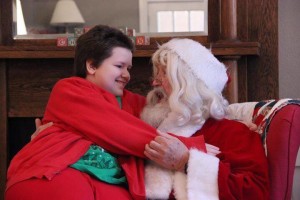
This young lady adores Santa and the opportunity to spend a whole 15 minutes with him.
Give each family a 15-minute appointment with Santa. Special needs kids, depending upon their disability, might need some time to warm up to Santa. The 15 minutes will also allow the photographer (who will shoot continuously) to take photos of the family together, siblings, etc. This is where it helps to have ESE employees as volunteers. They may know some of the children and have ideas that will help make it a positive visit.
- Enlist help on social media. From just posting what we were doing and what we needed, we obtained ink cartridges, photo paper, coloring books (to entertain kids while they wait for their pictures to print), toys/gifts, paper products, etc. We also located more volunteers this way. It helped to create a private group for volunteers as well.
-
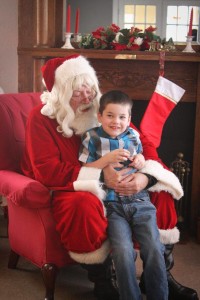
This photo was the first Jayden ever had with Santa. His mother left in happy tears.
Ask a local restaurant or two to help feed your Sensitive Santa staff. Two of us organizers made slow cookers full of soup. And a local restaurant made sandwiches to accompany them. Be sure to acknowledge them on social media.
- Secure a photographer. We hit the jackpot with ours. Not only is she a part-time professional photographer by weekend, she’s also an ESE teacher. She had experience in coaxing great candid pictures with special needs students, which is ideal. We also have a second amateur photographer who is a high school student. While our main photographer did the Santa sessions, the student photographer walked around and shot candids all day of volunteers, families, etc.
-
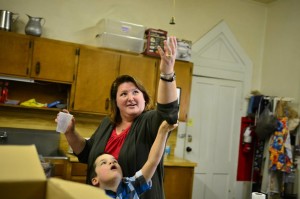
But here’s what we had to do to get that photo. First, the photographer took Jayden to tour the kitchen and the rest of the parish hall. Eventually, we got closer to the Santa room. And that was okay with everyone.
Hold a meeting with your volunteer staff. Brief them on each family attending. Prep them for the various disabilities represented. Volunteers will need to be reminded that certain children might become overwhelmed and adjust their approach accordingly. Other children will love to sit and color Christmas pictures with volunteers or watch holiday movies on a nearby laptop. Be sure to have someone whose job is to quickly remind Santa who is visiting next and to escort families in to Santa by saying, “Great news, Santa! Bobby and Mary are here.”
-

This sweet young man took in Santa with his senses.
Contact your local newspaper. Sharing the event with the community will help to ensure you have enthusiasm and donations/volunteers next year. It also makes for a beautiful Christmas morning front page article that will warm hearts.
- For the photo session, don’t worry too much about posed pictures. Place a chair next to Santa, and put no pressure on any child to sit on his lap. Some will run right to him and be happy to pose for a picture. By all means, take those pictures. But many, particularly those with autism, won’t ever look into the camera for a posed shot. Instead, focus on natural laughter and interactions. Take candid photos with a “photojournalistic” approach. Capture the shy child rolling on the carpet. The handshake with Santa. Back up and take a shot of a child sitting on his dad’s lap while dad talks to Santa. You might not get a “Santa picture” the first year. But the child will remember the positive, non-stressful interaction. And you might get one next year. Our goal is always the same. Children may enter crying. But we do everything we can to never have one leave crying. (It’s perfectly okay for parents to leave with happy tears, however!)
-
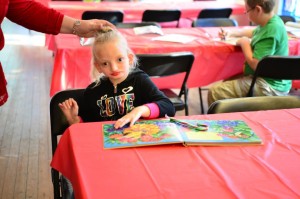
Children waiting on their pictures get to color, watch holiday movies, or eat cookies and hot cocoa — with no lines.
Print just two to three photos per family. To keep it simple, have two SD cards. As soon as a session finishes, the photographer hands the SD card to the printing volunteers. They look through the photos quickly and select the best two or three. They quickly print them and put them in an envelope. We then instruct the families to go to our Facebook page starting that night and the next day and look for their pictures to be uploaded. We include a letter from the photographer signing over all photo rights and permissions to families for the purpose of printing and posting.
-

Pretty sure this young man’s joy speaks for itself.
Make a social media post for each family’s pictures. That way they can share with family and friends. And they’ll want to. Many of these families will tell you their child has never had pictures with Santa. It’ll mean the world to them.
-
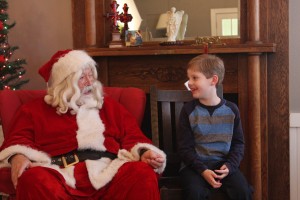
Sitting on Santa’s lap isn’t necessary. Just hanging out nearby is okay too.
Create a “best of” photo album (with one picture from each family) and cross-post to popular social media pages in your community. Be sure to tag your community partners. It’s great PR for next year.
- Make notes about what went well and what you might do differently next year. Start your planning again in September, and make it a tradition. It’ll be one of the happiest days of the year.




